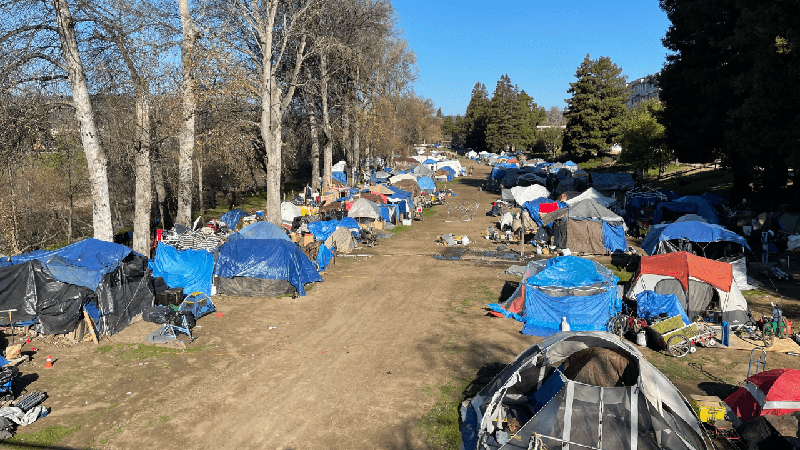Following the June 28 SCOTUS ruling on homeless encampment removal, Newsom brings the hammer down—but only after years of the state’s efforts to cushion the blow. Will it be enough?

A homeless camp in Santa Cruz, California in 2022, since disbanded. Peggy Dolgenos
How it Started
In 2018, the United States Court of Appeals for the Ninth Circuit ruled on a lawsuit filed by six individuals against the City of Boise for enforcing a ban on camping on public property.
In the Martin v. Boise case, the Ninth Circuit found in favor of the plaintiffs, stating that municipalities can’t enforce anti-camping bans if the number of available shelter beds was exceeded by the number of homeless individuals. The ruling was based on an interpretation of the prohibition on “cruel and unusual” punishment in the Eighth Amendment of the U.S. Constitution. As the United States Supreme Court declined to take up the case in 2019, the ruling of the Ninth Circuit stood.
Indeed, the criminalization of camping on public land when there is nowhere else to go is on the face of it cruel, and intended to cause the homeless to go on down the road.
Following the ruling, some affected counties and municipalities in the nine western states under the jurisdiction of the Ninth Circuit complied by designating certain areas for camping or parking of vehicles and minimizing police interactions except in cases of criminal behavior (theft, vandalism, setting fires, etc.).
On June 28, 2024, the United States Supreme Court ruled in City of Grants Pass v. Johnson that, no, enforcement of camping bans was not cruel and unusual, whether or not the homeless individuals had somewhere else to go, thereby overruling the earlier Ninth Circuit judgment.
In the days and weeks following the ruling, many cities and counties in California indicated that they were not going to immediately change direction in their homeless strategy.
Then, on July 25, 2024, Gov. Gavin Newsom issued an executive order for state agencies to clear homeless encampments on state property. And he’s encouraging counties and municipalities to do the same.
How It’s Going
The homelessness crisis in California is intimately linked to the housing crisis. There are not enough shelter beds for the unhoused; there’s not enough low-income housing, there’s not enough workforce housing; and there’s not enough affordable starter housing for first- time home buyers.
That there is a shortage of shelter beds for the unhoused is squarely on the shoulders of the Governor and state legislature, as California is responsible for funding public assistance through the counties—and that includes assisting the homeless.
And California lawmakers have been incrementally working to fulfill this responsibility.
One step was the Newsom-initiated CARE Court system, by which the state can compel California residents “suffering from untreated mental health and substance use disorders leading to homelessness, incarceration or worse” into treatment programs. Another was the passage of Proposition 1 by California voters in March 2024 authorizing $6.8 billion in bonds for mental health and substance abuse treatment facilities and housing for the homeless.
The shortage of low-income, workforce and starter housing is being addressed incrementally through state legislation and a coming California housing boom.
That the state is working to fix this immense problem, albeit slowly, is small comfort to six-to-a-two-bedroom-apartment renters, or the couple living with mom and dad while they keep trying to save up for a place—Much less so to those living in tents and cars who might find themselves rousted under the governor’s new order.
Meanwhile, housing starts for the various tiers of affordability are in the pipeline or being completed. Several hundred units of housing just opened for lease a couple blocks from where I’m writing this in Santa Cruz. A couple hundred more units of housing for local unhoused is opening soon, a couple miles away.
Things move slowly through the pipeline, but they do move. Statecraft takes time.
Short articles summarizing reporting by local news sources with linkbacks to the original content.